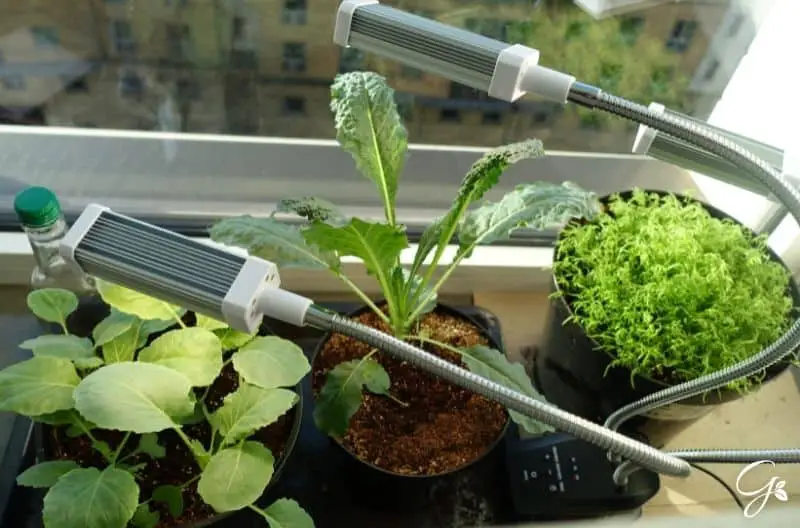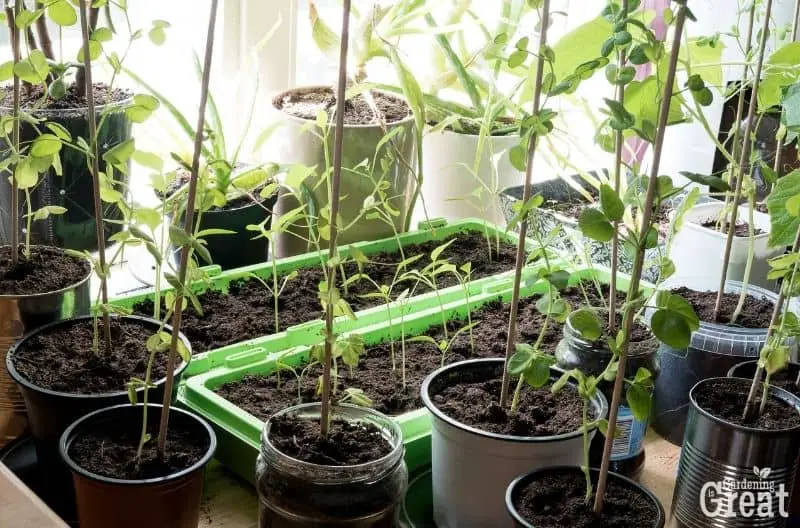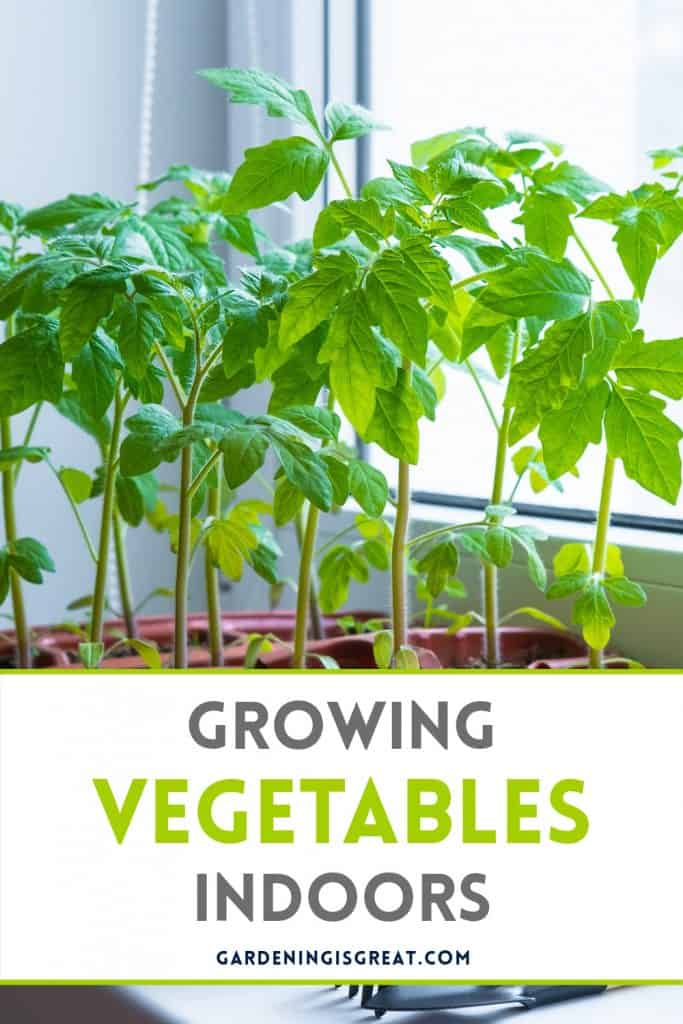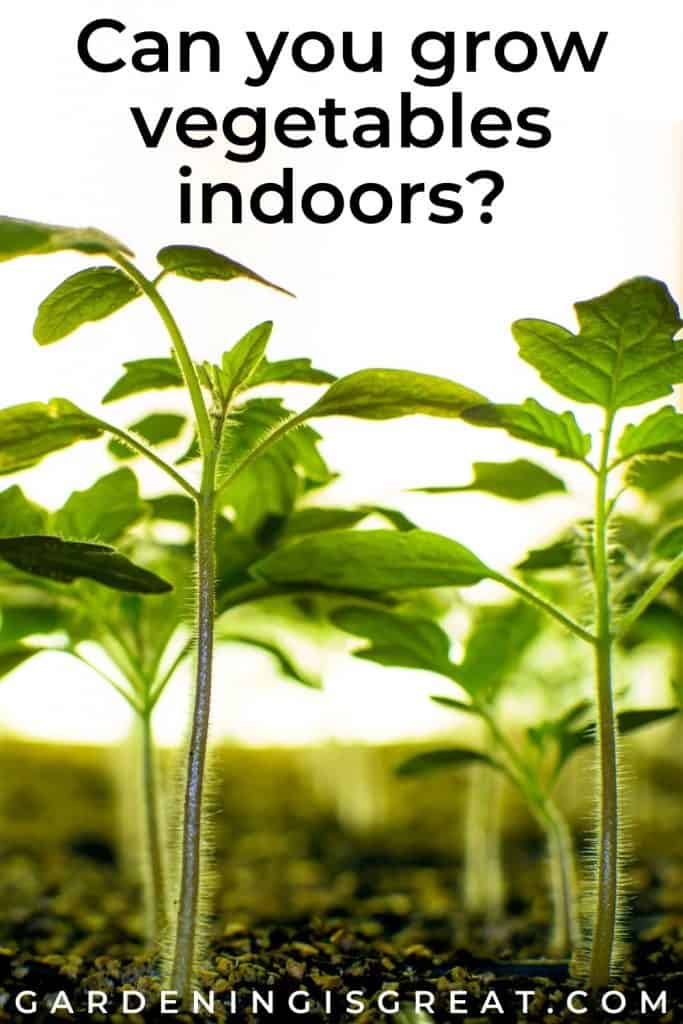A Guide to Growing Vegetables Indoors for Beginners
Growing vegetables indoors is possible, even for beginner gardeners. With the right choice of plants, conditions, and care, you can have vegetables growing indoors in a matter of weeks.
If you are planning to grow vegetables indoors, then I highly recommend taking a look at this guide. Especially beginner gardeners, this guide will help you
- choose which vegetables to grow indoors,
- what they need,
- and how to take care of them.

Can you grow vegetables indoors?
Yes, you can!
Perhaps you live in an apartment, have a small backyard, or want to grow your own vegetables in the middle of winter.
Whatever your reason is as a beginner gardener looking to grow vegetables indoors, rest assured this is possible. By growing vegetables indoors:
- You can control the temperature and lighting conditions
- Have easy access to vegetables for cooking with
- Manage unwanted pests
- Grow vegetables all year round.
How to start growing vegetables indoors?
For beginner gardeners, it is really important to plan ahead. This ensures you have the resources you need to grow vegetables indoors successfully.
But also selecting the right vegetables for the conditions in your home and space.
What are the best vegetables to grow indoors for beginners?
For beginner gardeners looking to grow vegetables indoors, it is best to start with the easiest to grow. These would be your leafy greens that prefer a cooler environment such as lettuce, spinach, watercress, and peas.
Here is a list of vegetables that prefer a cooler temperature and are ideal for growing indoors:
Kale
Kale grows very well potted indoors. Though it won’t grow as tall as if it were planted outside, it still grows healthy and strong. Plus, with the leaves being smaller in size, they are sweeter in taste.
Kale does like a bit of sunlight in order to grow, so if possible, ensure to place your potted kale in front of a window, or, under grow lights.

Spinach
Spinach is a quick and easy choice of plant to grow indoors. Unlike many plants, spinach grows well in partial shade so try not to leave your spinach to grow near a window that gets lots of sun.
Lettuce
Lettuce loves the sun. For maximum growth, ensure you leave your lettuce to grow in a place that gets full sunlight all day. Lettuce grows really quickly when given the right conditions. Your lettuce leaves should be ready to harvest within 3-4 weeks.
Carrots
Depending upon the space in your home and the size of your pots will then depend on the variety of carrots you grow. If you do not have much space, then smaller varieties of carrots are your go-to choices such as Chantenay, Romeo, and Babette carrots.
This vegetable grows successfully when the soil around it is kept moist, so ensure to regularly water your carrots.
Potatoes
Potatoes are one of the easiest vegetables to grow indoors and are a great choice for beginners. However, they need quite a large container or pot to grow in. Planting them in a small container will lead to a small yield of potatoes.
Also, ensure that your container has good drainage. Potatoes do not thrive in wet conditions and are best when the soil is moist but does not contain excess water.
Arugula
Arugula is another great vegetable choice for growing indoors. This leafy vegetable does very well growing in sunlight with moist soil. The leaves are ready to harvest after just 4 weeks.
Peas
Peas are a vegetable that requires a lot of sunlight. If growing indoors, ensure to place your pots in a part of your home where they gain lots of natural light. A few easy-to-grow varieties are snow peas, dwarf peas, and snap peas.
Unlike other indoor vegetables, peas do need a bit of extra support such as a small stick to attach the shoots to, and help them grow upright.
Scallions
Scallions are a type of sweet onion that is incredibly easy to take care of. Long green, grass-like blades grow from a very small bulb in the ground.
By growing upright they don’t require lots of space and they also do not need lots of sunlight. This makes them an ideal vegetable to grow for beginners.
Radishes
Growing radishes indoors for beginners is a good choice as they are relatively easy to look after. Radishes do require a good amount of sunlight and a deeper pot due to the length of their roots. Radishes grow quickly and are ready to harvest in 4-6 weeks.
Beets
Beets or beetroot is a root vegetable that can grow well indoors. However, being a root vegetable, and due to the size it can grow to, it needs a deep pot of approximately 18 inches.
Beetroots grow best when they have access to sunlight throughout the day. Beetroots are best harvested when they are no bigger than a golf ball.
Herbs
Herbs can grow really well indoors with many thriving when grown in pots. If you’d like to grow herbs indoors too, consider starting with thyme, oregano, and sage. You can read more about growing herbs for beginners in this guide.

What do you need to grow vegetables indoors?
Now that we know which vegetables are the easiest to grow indoors for beginners, let’s learn what they need to grow and thrive:
Containers with Good Drainage
Most vegetables do not grow well in an excessively wet environment. So not only is it important to not overwater your indoor vegetables, but also ensure the containers you plant them in have good drainage.
If you have chosen to plant them in seed trays, often the trays already have holes in them to drain away excess water. Just ensure to buy a tray that doesn’t have any holes to catch this extra water.
Alternatively, for your root vegetables that need a deeper container, you can poke holes in the bottom of the pots to enable water to drain from the container.
A Light Source
If you were growing your vegetables outside, they would gain natural light from the sun. But when growing vegetables indoors, you are limiting access to the sun.
Hence, you can either ensure to place your plants indoors where they would get the most sunlight e.g. on a windowsill.
Or, if you do not have much space by your windows, you can purchase artificial lights. Artificial lights can provide either just lighting, or you can purchase grow lights that also offer heat at a warmer temperature.
Light is important for photosynthesis as well as for providing warmth. Without light, your plants will die.
Water
All plants need water to survive. However, the amount of water can vary from plant to plant. A good rule of thumb for most vegetables growing indoors is to dip the tip of your finger into the soil.
If the soil feels dry, add some more water. If the soil feels quite moist, then your vegetables already have enough moisture.
Check the soil and moisture levels daily to help your vegetables to grow.
Also note that if you choose to grow root vegetables, they may require more water than others as their roots and the growing vegetable itself is deeper in your pots. Hence you need more water to penetrate the soil at a deeper level.
Your leafy green vegetables may only require the leaves misting with a spray bottle each day.
Soil
Ensuring you use healthy and nutrient-full soil to sow your vegetable seeds and clippings into is important. Your vegetables will gain the nutrients they need in order to grow from the soil around them.
Ideally, purchase a bag of compost to plant your vegetables with. Compost comes with extra nutrients plus, it is loose and can support the drainage of excess water.
Growing vegetables indoors is a great option for beginners due to the minimal maintenance required. Carefully choose which vegetables are right for the space you have indoors along with the amount of sunlight you can offer.
With planning, time, and care, you will have yourself an indoor vegetable garden ready to start harvesting and enjoying in as little as 4 weeks.


If you liked this post, we think you may also like these:

